Targeting: Best Practices for Higher Ed Marketers

Higher education institutions face unprecedented problems such as enrollment declines and underfunding. Students have more options to choose from besides traditional four-year universities, ranging from online colleges to Massive Open Online Courses.
As the landscape evolves, the higher ed market continues to saturate. Economics tells us that when a market gets more saturated with competitive options, organizations tend to drop prices and cut costs to compete. These, however, are not long-term solutions for anyone, higher ed included.
In order to survive, higher education institutions must understand the best way to target their prospects. It’s about engaging the right prospective students, at the right times, and with the most relevant and impactful information.
This article will show you how the right value proposition, student personas, and paid targeting strategies make for the best admissions results.
Value Proposition
A value proposition is a brief statement describing the benefits students can expect from attending a specific school. It’s a crucial part of a school’s inbound marketing strategy and should reflect what your brand stands for – and of course all higher education institutions are brands as well as places of learning. Like businesses with brands, they deliver a unique value and experience that builds an emotional connection that endures long after someone graduates. Having a clear value proposition and messaging defines and communicates the primary value a school provides.
A strong value proposition can help you convert the right students who are still searching for higher education experience. When you develop your value proposition, you should consider three main components:
1. Differentiator
What makes your school different from the rest? While reputation holds weight, a university’s name is not as important to students’ decision-making process as it used to be. Prospective students are focused on utility, benefits, advantages, or usefulness they can get from your school that they can’t get from the competition.
2. Target Audience
Traditional four-year universities typically want students who seek the benefits of an on-campus experience. So, it’s important to speak to that audience. A broad “spray and pray” targeting method for higher education does not prove to be efficient or valuable. You want to target students who are qualified and interested in your programs/value prop. Student personas are a great tool for helping a college identify and understand its target audience.
3. Emotion
A value proposition needs to evoke an emotional response. A strong value proposition will resonate with a prospect. Ideally, they will respond by thinking, “That’s exactly what I was looking for.” Schools must understand where their prospective students aspire to go next in life, and how they can help them get there. Aspiration is a more long-lasting emotion than inspiration and should be the prioritized emotion your value proposition seeks to evoke.
If you're not sure where to start with defining your value proposition, we suggest interviewing students who have recently graduated from your programs. But even if you have one already, it’s good to periodically review it by talking to graduates. What did they gain? Where did they go to work after attending your school, and what are they doing now? Studies from the National Association for College Admissions Counseling (NACAC) have shown that Gen Z relies heavily on peer-reviewed content. Getting a gauge on your recent graduates’ success is a great way to help craft your value proposition around what your target students care about most.
Here’s are a few examples of a strong higher ed value proposition:

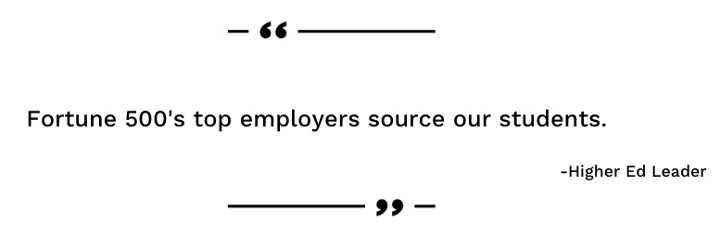

Personas
Colleges and universities are no different from businesses in this regard: they need to get a crystal-clear understanding of their customers (if a business) and prospective students (if a college). Higher education institutions would do well to do what businesses do and create a persona.
A student persona is a composite representation of a school’s ideal student applicant. It’s based on a combination of real data about a school’s existing students and market research. Creating student personas helps schools understand their target audience by getting into the headspace of a prospective student. They help you uncover what matters to your target students, and. in turn, what your school needs to promote in your advertising (which will discuss below) to engage them.
Some of the most common elements of a student persona include:
- Demographics – age, ethnicity, education, income, gender, race, location
- Goals/motivations – what are your students career goals, life goals, aspirations
- Preferences – what is your students preferred learning style (online, in-person, hybrid).
- Affiliations – is your student apart of any clubs or sports team
- Challenges – what roadblocks or struggles does your student face?
- Lifestyle – how does your student spend their free time?
Personas can even include a visual depiction of the ideal student. A good persona helps a college humanize its target student and put themselves in their shoes.
Featured below is a great example of a persona profile template:
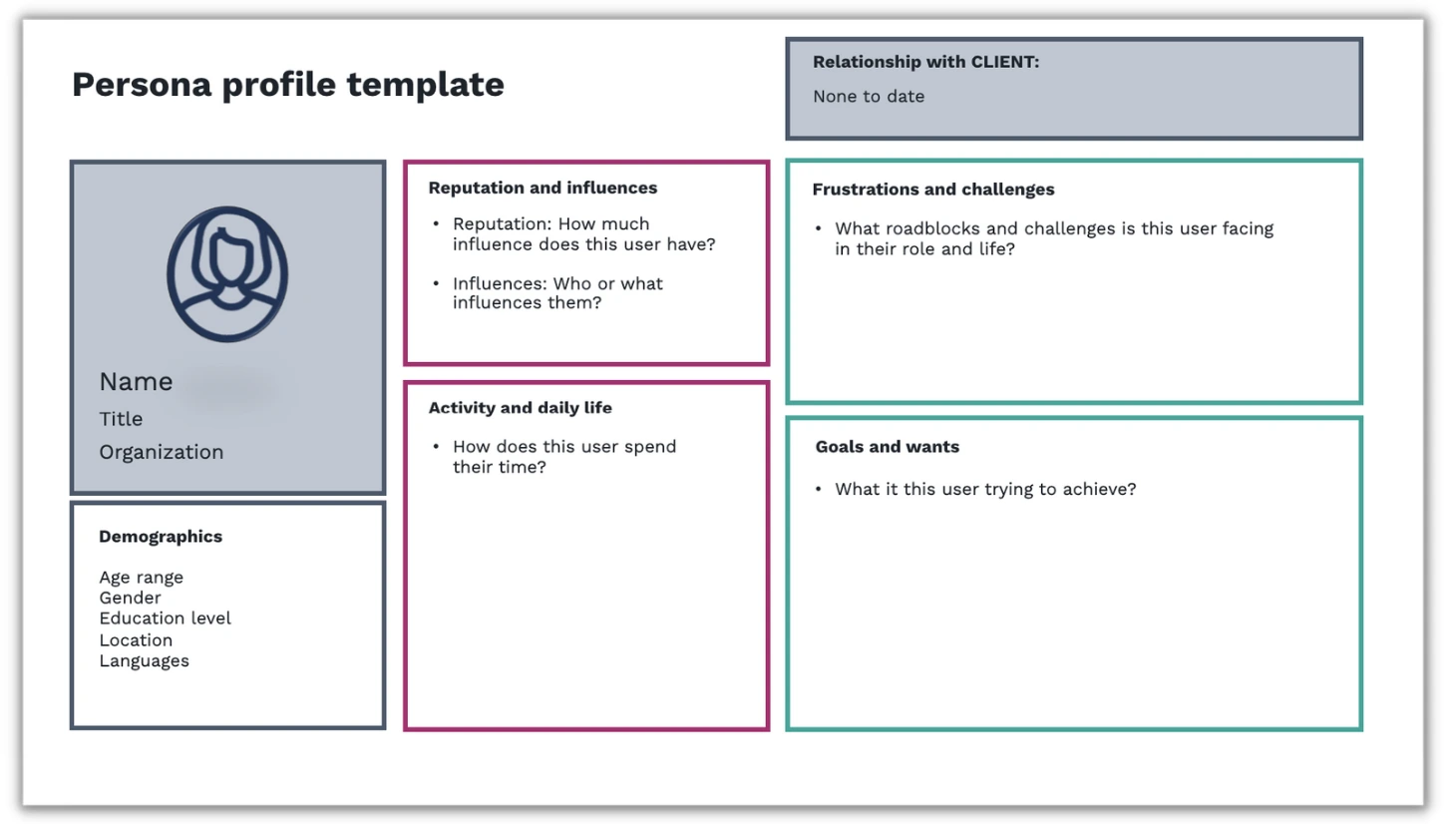
Schools can utilize their first-party data to determine their persona elements. First-party data is information the schools collect from their audience directly. As the digital world prepares for the deprecation of third-party cookies, utilizing first party data will be a crucial step for schools to understand who their students are.
Student personas should provide data on the student experience at each point of the decision-making process from awareness to consideration, to decision, to application and finally, enrollment.
So, how many personas should you have? Short answer: it depends. There’s no magic number, but ideally a good benchmark is typically three to eight. Too many personas can lead to segmenting your audience so much that creating content for each individual persona is simply impossible and dilutes your focus. Not having enough personas will result in your lacking a complete picture of your audience.
Before putting your personas into action, it’s important to remember that these are not “set-it-and-forget it” templates. Personas should be agile and reevaluated quarterly for optimization to ensure the best results. To learn more about building personas, check out our audience persona article here.
Segmentation
Segmentation is the act of categorizing your student personas into specific groupings for your ads. Segmenting your student personas is important for ad targeting because it gives you an idea of what channel to focus on when setting up your ads.
Segmenting is a practice used by businesses to understand different consumers they want to target. To be sure, students are not “consumers,” per se, but it’s useful to consider them in context of consumer segmentation in order to understand how to attract them with the right ads at the right time. After all, they do go through a journey to learn about your school just as they learn about products before they buy them. But in context of learning, of course, a student is choosing not to buy a product but rather to attend college -- and all the knowledge and experiences they will benefit from when they do. Noting this, it’s important to take consumer psychology into consideration and apply the same principles of segmentation to understand how to reach prospective students. For instance, today’s consumers continue to demand a more personalized experience from brands -- and this reality affects how they think of their important life choices, such as choosing where to go to college. When done correctly, segmented and highly targeted campaigns bring in about a 77% marketing ROI. Schools can use this data to personalize their recruitment marketing strategies with a “student consumer” in mind to successfully segment their personas for ad targeting.
Both personas and segmentation are important to understanding your students’ journey, defining your value proposition and setting up your targeting strategy. You can’t fully form your value proposition until you have a clear understanding of your student persona. Once personas, segmentations, and value propositions have been defined, schools can begin target ads.
Ads
When setting up ads, schools must first define what their goals/KPI’s are. Once you have a clear understanding of what you’re trying to achieve and how to track it, you can determine what you are going to advertise and what channels you’ll advertise on.
There are three prominent channels higher ed marketers should consider when it comes to targeting prospective students: social, search, and display.
Social Ads
Social targeting utilizes social channels like Instagram, YouTube, Facebook, Twitter, TikTok, and Snapchat to deliver ads to the audiences you segmented during the previous step described above.
In a digital-first world, Gen Z is heavily influenced by social media. In fact, 97% of Gen Z consumers use social media as a top shopping inspiration. (And it goes without saying that choosing where to go to college is a major financial decision for the student and their family.) Because of this, social targeting is crucial when it comes to reaching and influencing your ideal student.
Social media ads are not targeted based on keywords, but instead on demographic and psychographic data. Therefore, it's important to utilize various sets of ad copy and creatives within your social campaigns. By running various social ads and testing different calls to actions and visuals, you can learn which assets drive the best engagement with your unique audience. Three main messages you could consider when developing your campaigns are:
1. Benefits
Highlight your degree programs, flexibility, affordability, ROI, and other key benefits.
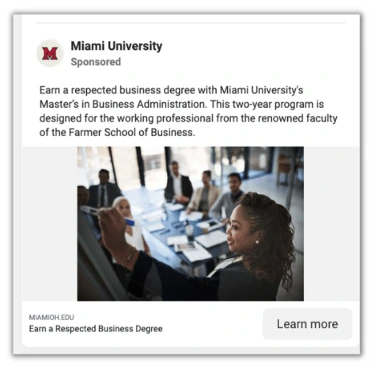
2. Expectations
Share student diversity, campus, activities, and events to give prospective students a sneak peek of life at your university.
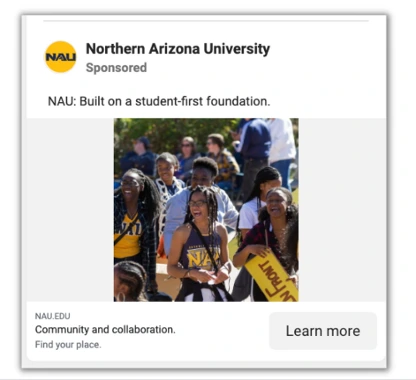
3. The "why"
Showcase school rankings, accreditations, acknowledgements, alumni successes to solidify your value proposition.
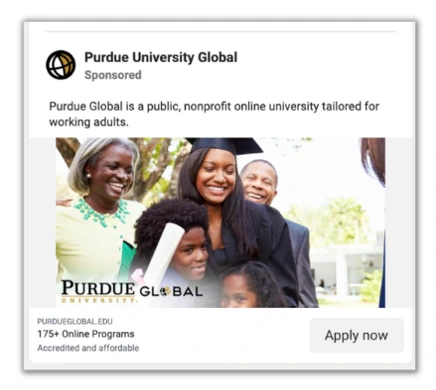
Knowing who your prospective student is, what they care about, and how they make decisions will help you create engaging social ads that have a higher chance of conversion.
Search Ads
Search engine advertising is the act of listing ads on search engines, like Google or Microsoft (Bing), in order to be prioritized at the top of relevant search results. Search ads are beneficial for higher education marketing because they are placed alongside information your target students are already searching for online.
These ads allow you to target both prospective students’ and their parents’ searches directly, giving you the ability to bid on keywords and craft custom listings.
Parent searches are equally as important as student searches, as Google restricts ad targeting on users under 18. Recent studies from the Education Advisory Board (EAB) have shown that out of a 5,000 high school senior survey, 48% ranked “parental influence” as a top source of their admissions process/decision.
Search ads are a great tool for more immediate conversions, because they’re more intent based. You’ll also be able to tailor your phrasing and drive traffic to specific pages on your website.
These types of ads typically have a headline, URL, and minimal copy. The image below provides an example of three schools search ads for the keyword “marketing programs Arizona”:
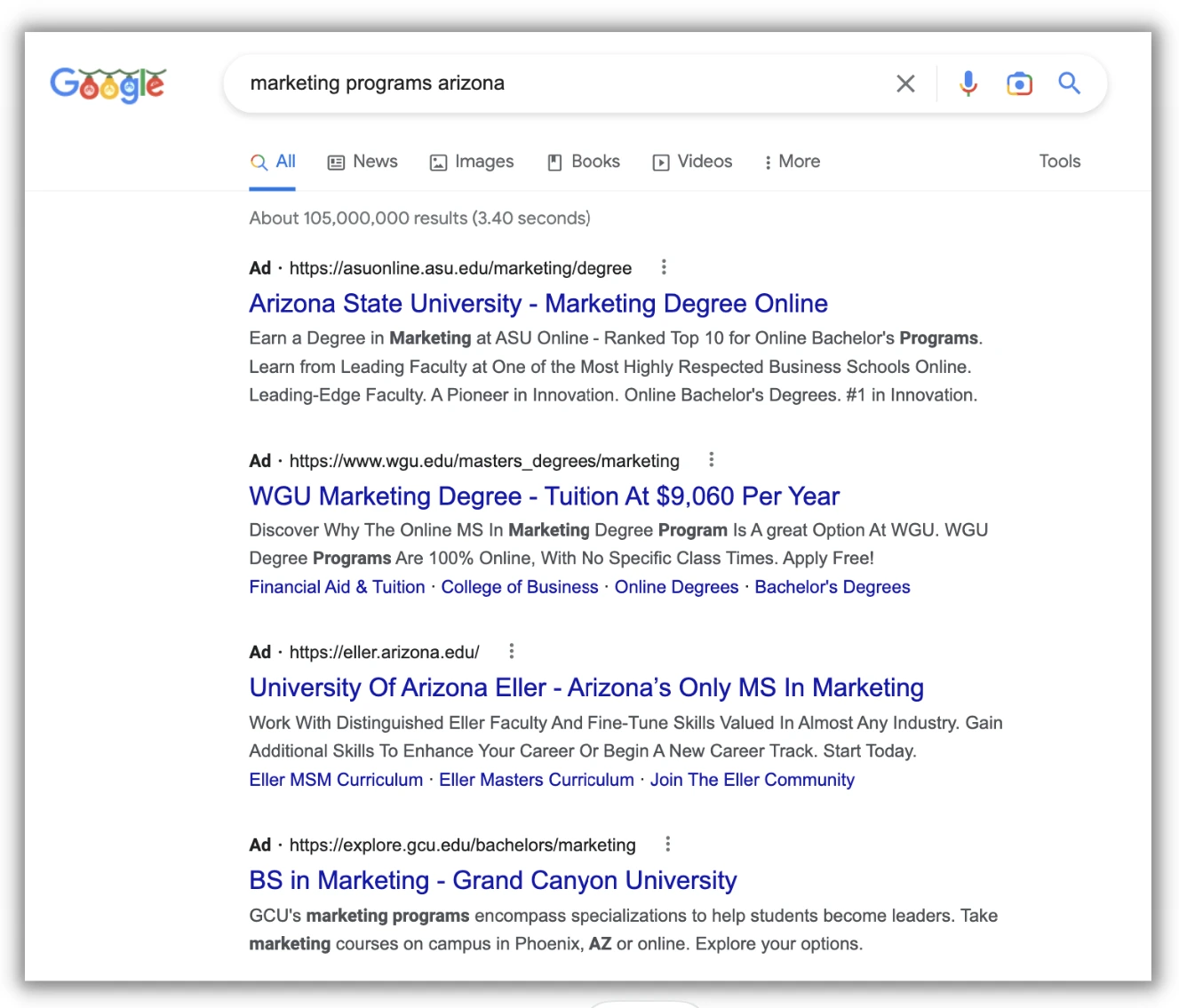
Because these ads are keyword based, it’s important to consider what your prospects are looking for in a school. Your student personas will be helpful when learning what keywords, you want to be ranking for.
Display Ads
Display ads are heavily image-based but can also be in the form of text. These ads appear on articles, videos, or websites your consumers browse and can appear across multiple sites.
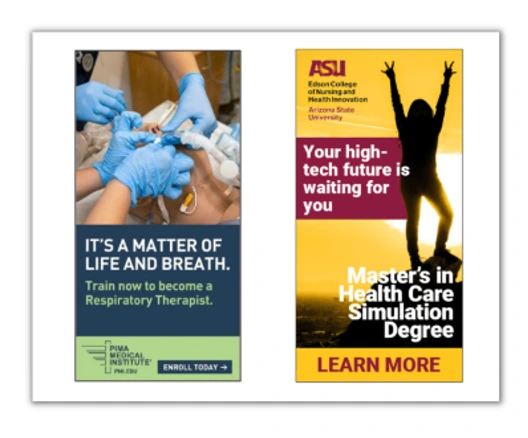
Display ads are a great tool for higher ed marketers because they work to increase:
- Brand awareness - helps you reach new students
- Lead generation - helps drive clicks to conversions
- Lead quality - precisely targets students based on demographic criteria
Higher education institutions have a few options for targeting students via display ads: Google, Bing, and programmatic.
Google has been a dominating force in the search engine world for years. It has a larger search volume and reach compared to Bing. With over 4.3 billion people using Google for their searches, it’s safe to say that Google Display Ads are a great marketing tool.
Google also generally caters to a younger, more tech savvy audience, which is perfect when looking to target prospective students. The Google Display Network (GDN) can serve display ads across over 2 million websites and apps.
A few display ad types you can expect with Google include:
- Responsive Display
- Image Ad
- Video Ad
- Animated Ad
- Discovery Ad
- Performance Max Ad
All the above can be beneficial in your higher education targeting strategy. You can learn more about each of these types in depth here.
Bing
While Google has held a lead in the search engine market, Bing shouldn’t be underestimated. Bing has its own version of the GDN, called Microsoft Audience Network (MAN).
Bing display ads can reach across these Microsoft owned properties: Microsoft Edge, MSN, Outlook, Windows, XBOX, CBS Sports, and Fox Business. These ads also include three Microsoft-owned search engines (Bing, Yahoo, AOL). So, when you’re advertising on one platform, your ad can be seen across all three of the search engines.
There are two main display ads that the MAN supports: image- and feed-based.
It’s important to note that Bing users are often an older demographic compared to Google users. Bing usage statistics show us that about 70% of their users are 35 years old or older (Market.us). This is where the parent search information mentioned earlier can also be used.
Programmatic
Programmatic advertising is the automated process of buying and selling advertising space. Programmatic has become more popular over the years. It’s expected that by 2026, 86% of overall digital advertising will come from programmatic ads. This is a strong tool schools can use in replace or alongside of their traditional media forms (billboards, mailers, etc.) to increase brand awareness.
By combining your student personas and first-party data with programmatic ads, you’ll be able to easily identify which of your prospective students are receptive to your marketing and reach hyper-targeted audiences.
Programmatic ads are great for reaching today’s prospective students, who are typically tech-savvy and mobile focused. They allow you to connect with your engaged prospects across diverse digital platforms anytime, anywhere in a cost-effective and innovative way. You’re more likely to see a greater ROI, as every ad space you purchase is specifically targeted towards the most receptive audience.
These ads give you the ability to scale early on – which, in turn, helps maximize your retargeting pool and drive campaign efficiency. A bigger scale also means more data you can use for future optimization.
Just like personas, targeting ads are not a set-it-and-forget-it effort. You’ll want to continuously check on your ads to see what’s working, what’s not, and how to optimize for the best results.
Direct buys
Another type of display ad you might hear about is direct buy. This is when advertisers work directly with a publisher to purchase ad space. While there are great benefits to this approach, there are some things to be aware of when deciding if direct ads are best for your school’s marketing strategy:
- A direct buy doesn’t give you the ability to track your students across multiple sites
- These ads target the publisher’s user base, rather than your own
Creative messaging
Regardless of the ad targeting format you choose, keeping your messaging fresh and creative is crucial. Your content should be relevant, evergreen, and valuable to your audience. Some examples of content to create when targeting prospective students include: landing pages, white papers, testimonials, and videos.
Another way to keep your messaging creative is by driving traffic to different pages on your website. Whether you’re promoting a degree, program, campus attraction, etc., you’ll want to direct your prospects to your most relevant web pages for a higher chance of conversion versus directing them to a general homepage.
While it’s important to get creative across different channels with your ads, it’s just as important to keep your branding and messaging consistent. Variables such as colors, text style, and tone should be consistent across all ads to ensure a strong brand identity and cohesion.
Contact IDX
To learn more about putting these best targeting practices into action, contact IDX. We can help you dominate the higher education market. Our digital marketing experts are happy to consult and help you exceed your enrollment goals. In addition, our white paper Higher Education Marketing: Six Trends in Online Higher Ed provides more insights into how higher education can succeed with an integrated marketing approach.
Download the white paper to start increasing enrollments.
Let's chat
Whether you're looking for service, support or a future strategic partner - we're here to help.
Offices
LDN
London, UK
A mixing pot of every colour, from red buses to black cabs.
Counting House
53 Tooley Street
London
SE1 2QN
GOT
Gothenburg, Sweden
A vibrant city with a rich maritime history.
Hälsingegatan 12
414 63 Gothenburg
Sweden
HEL
Helsinki, Finland
Don’t let the cold scare you off, our office is nice and warm.
Mannerheiminaukio 1 A
FI-00100 Helsinki
Finland
VAD
Vadodara, India
Enter our bustling world of great people and even greater food.
Business Park East, Alembic Road
Vadodara-390003, Gujarat , India
PHX
Phoenix, USA
Visit our oasis in the desert where the sun never stops shining.
11201 N Tatum Blvd, #200
Phoenix, AZ 85028
NYC
New York City, USA
You won’t find a better bagel anywhere else in the world.
240 W 37th Street, 7W
New York, NY 10018
